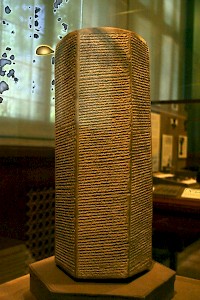The Sennacherib Prism
Sennacherib Prism: text of the Annals of the Assyrian king Sennacherib, famous for a reference to the siege of Jerusalem in 701 BCE also mentioned in the Bible.

In the last quarter of the eighth century BCE, the Assyrian kings Šalmaneser V (r.726-722) and Sargon II (r.721-705) had expanded their empire to Israel. Samaria fell in 724 or 722. Although Menander of Ephesus mentions a (probably unsuccessful) siege of Tyre, its King Lulli managed to retain his independence, staying outside further conflicts, and expanding his rule (or continuing his rule) in Kition and in Sidon. In 701, however, the Assyrian king Sennacherib (r.705-681) decided to terminate Lulli's rule.
He describes his campaign in his Annals, which are known to us from the Sennacherib Prism, now in the Chicago Oriental Institute. Note in the fragment below that only Old Tyre is captured. Tyre itself, situated on an island, was not taken and Lulli continued to rule over there. Another remarkable point is that Tuba'lu paid an annual tribute - in other words, a normal system of taxation was introduced.
This Sennacherib Prism has become famous because it also describes the unsuccessful siege of Jerusalem. The translation below was made by Mordechai Cogan.
The Sennacherib Prism
[ii.37-49] In my third campaign, I marched against Hatti. The awesome splendor of my lordship overwhelmed Lulli. king of Sidon, and he fled overseas far-off. The terrifying nature of the weapon of Aššur, my lord, overwhelmed his strong cities, Greater Sidon, Lower Sidon, Bit-Zitti, Sarepta, Mahaliba, Old Tyre, Akzib, Acre, walled cities, provided with food and water for his garrisons, and they bowed in submission to my feet.
I installed Tuba'lu on the royal throne and imposed upon him tribute and dues for my lordship, payable annually without interruption.
[The text continues with a description of the siege of Lachish and Jerusalem; cf. 2 Kings 18-19.]